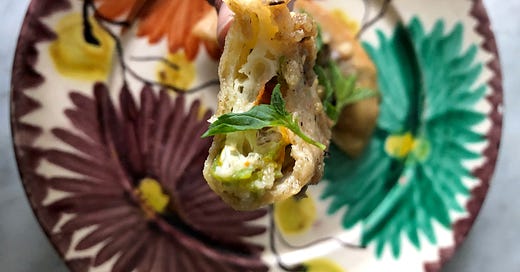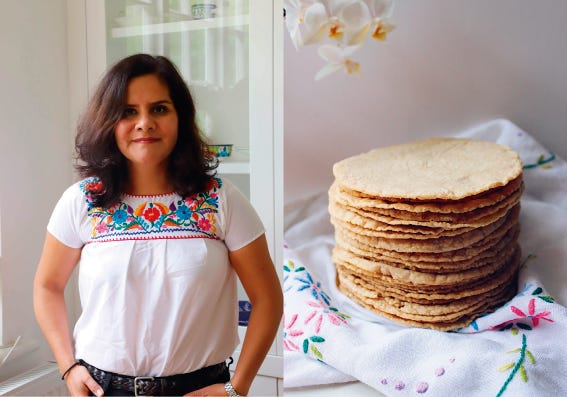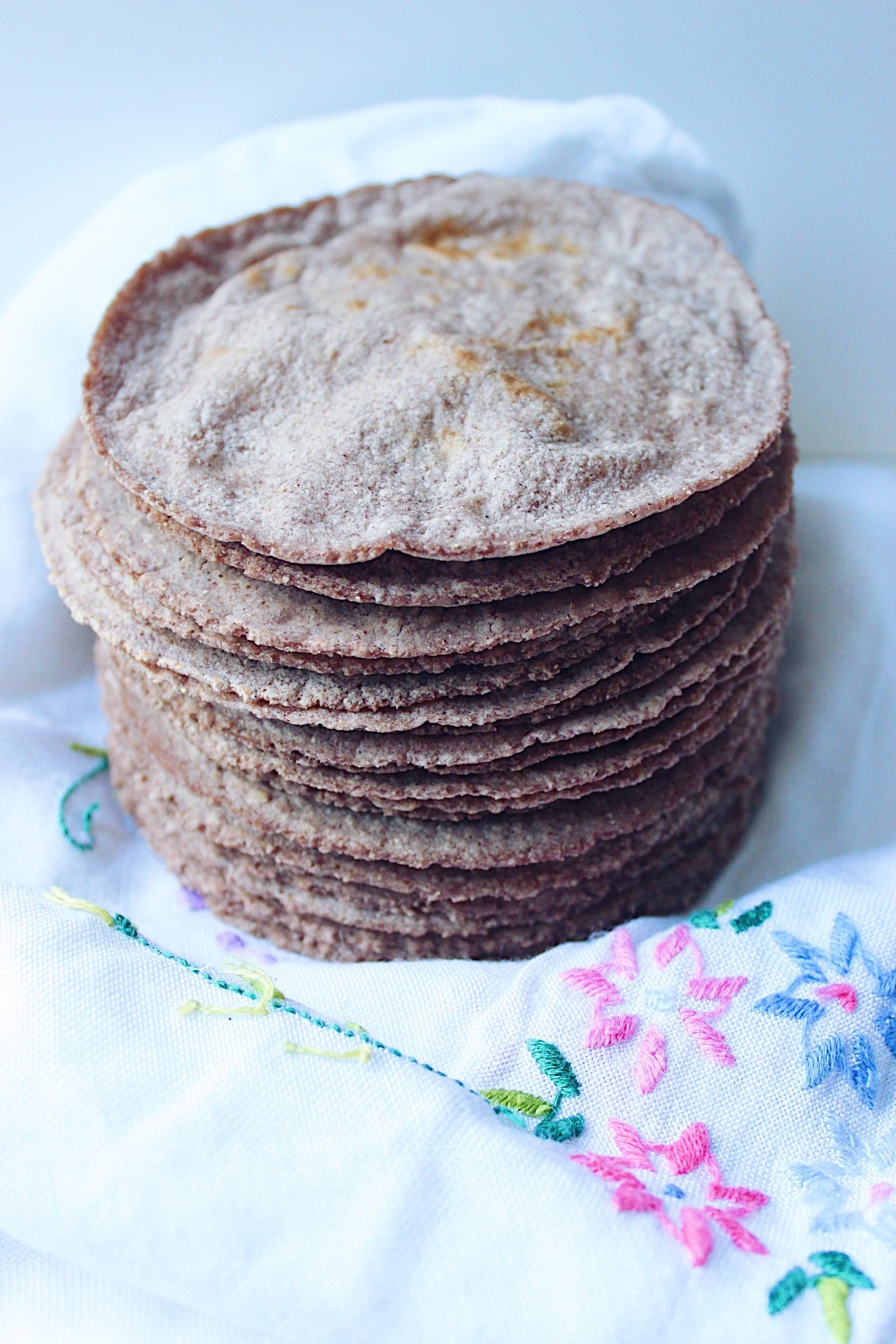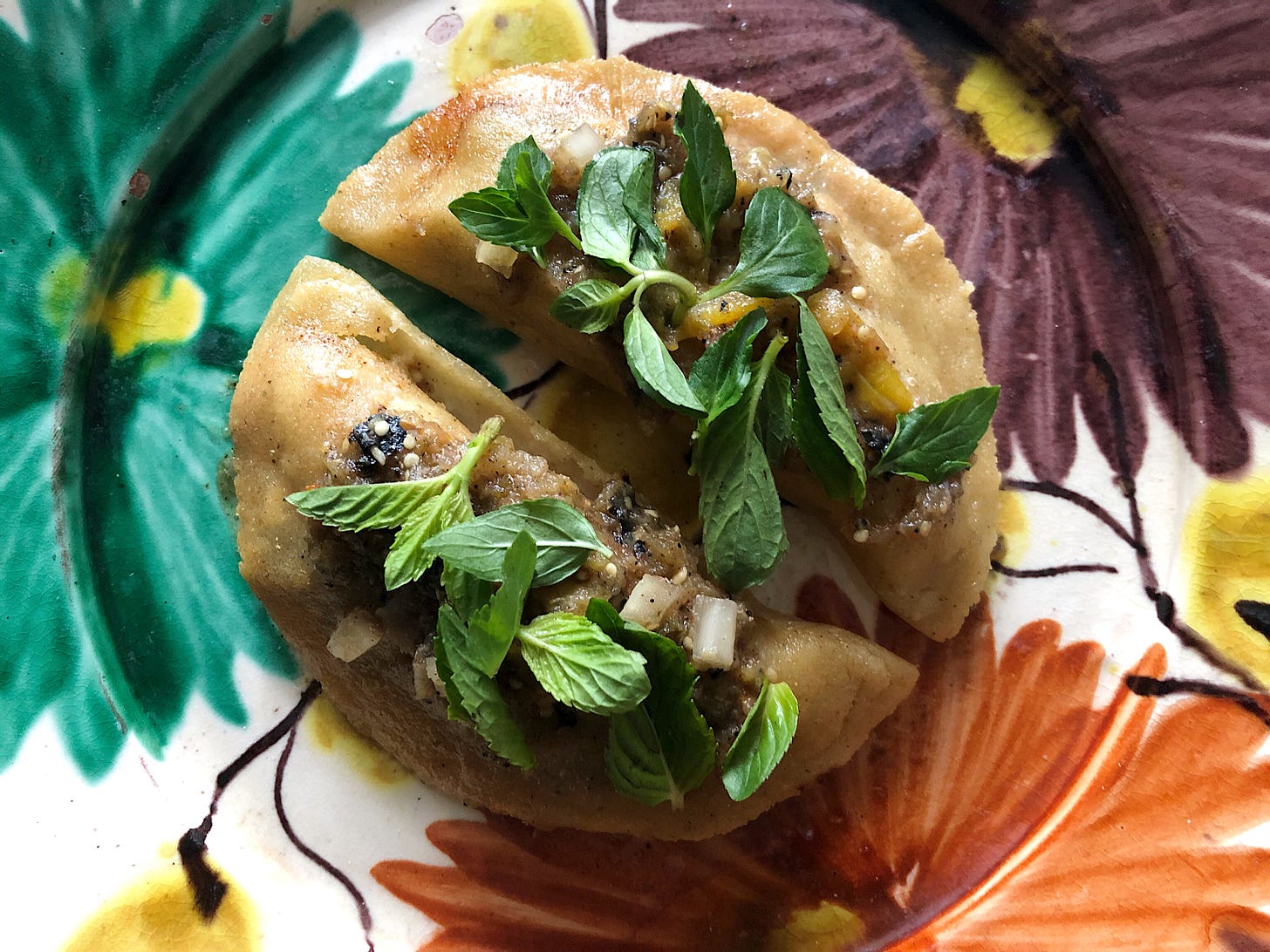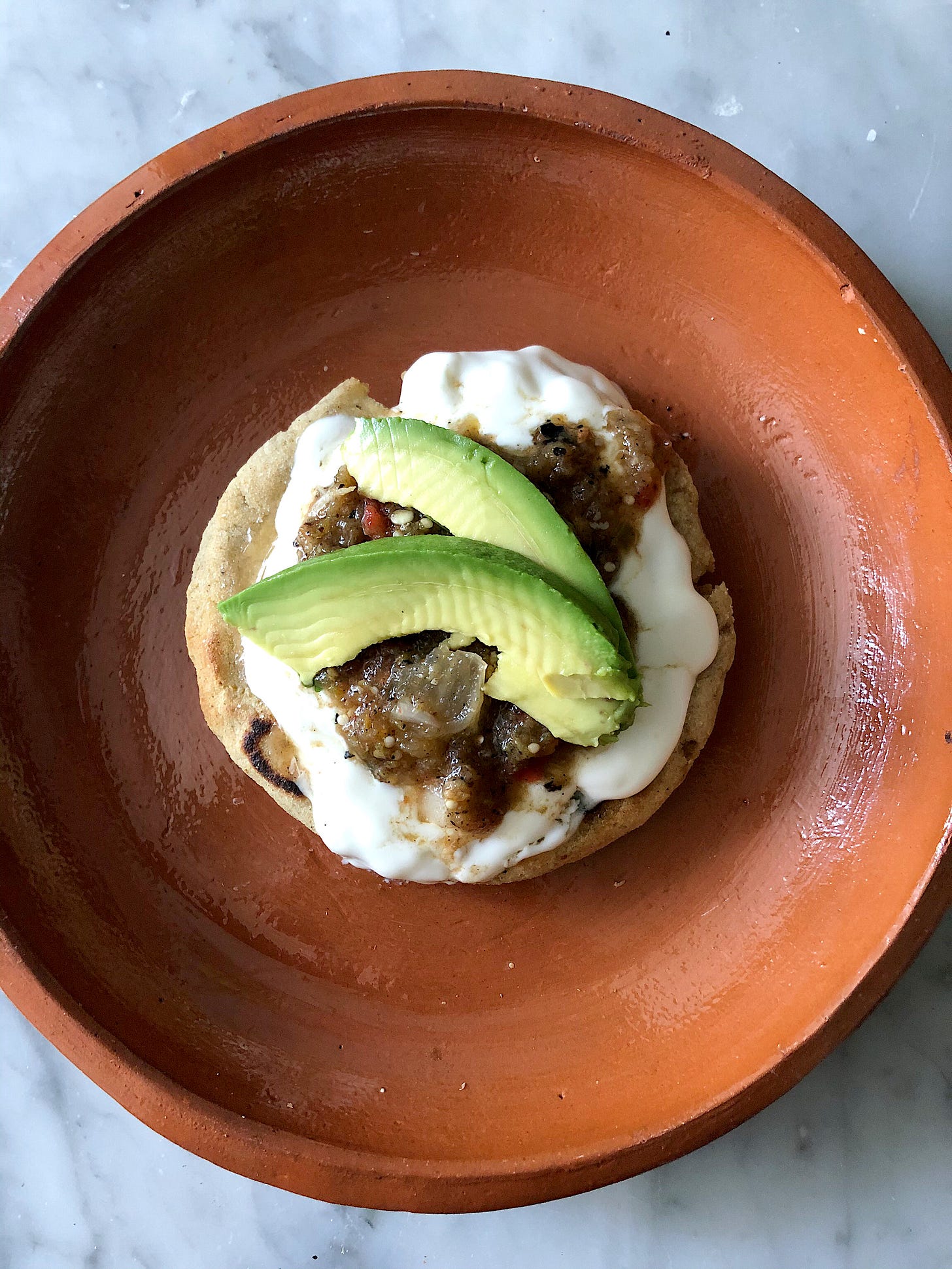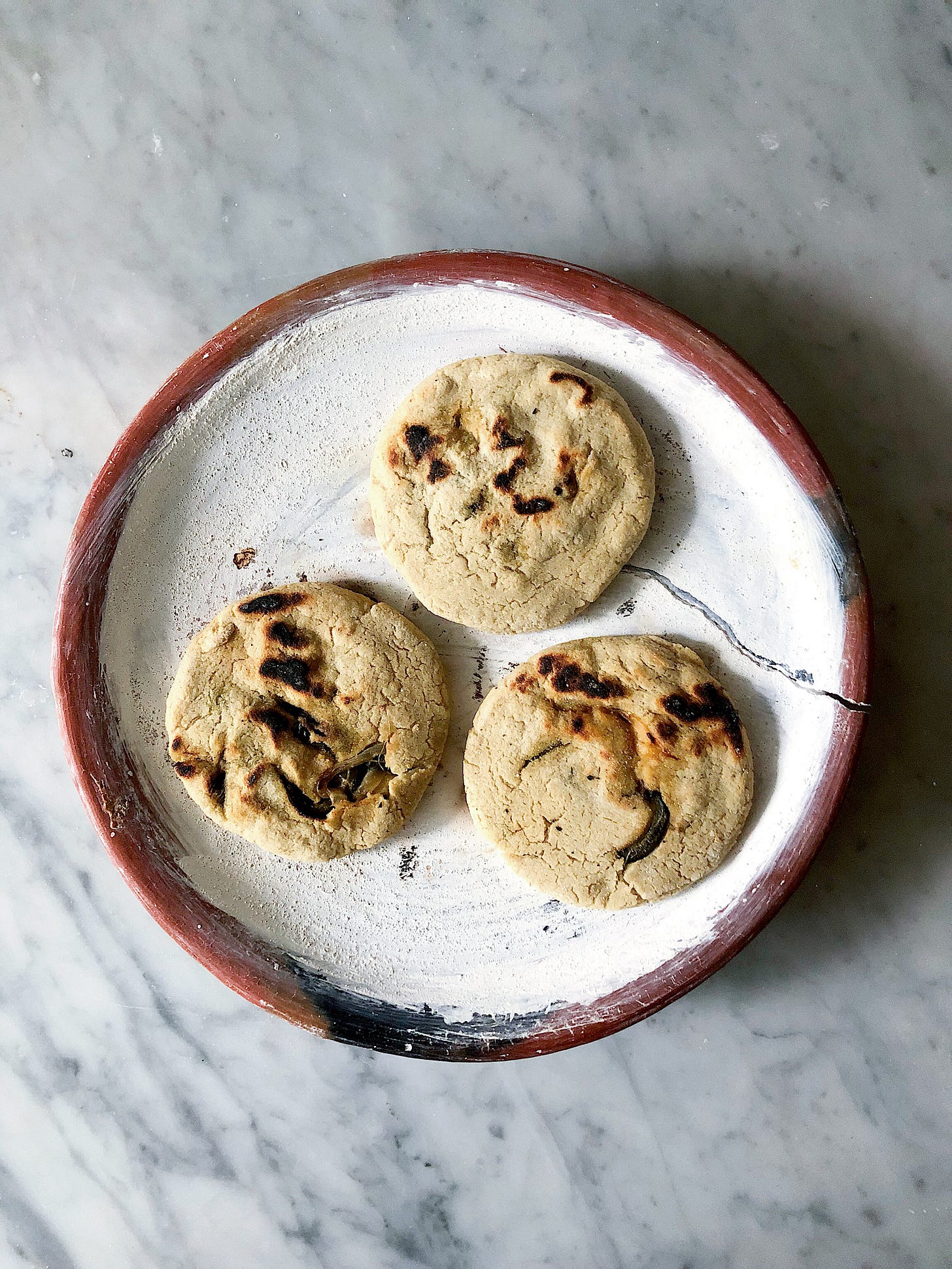OUR MOTHER CORN. Gorditas encuevadas, empanadas de hierba, different ways to make tortillas, and other corn masa based foods.
Cooking heroines part IV
We construct narratives in our minds to make sense of reality, to fill the vertiginous hole of life’s uncertainty. But when those stories fail to convince us anymore and we found ourselves in the middle of nowhere, we can always plant a seed in the ground and hope for it to turn into something that can feed us. Many ancient belief systems that continue to hold communities together these days are centered around this idea; like that of the pueblos originarios of America, who even through the mediation of catholic images and at the expense of colonization and capitalism, have managed to preserve a profound bond with nature that arises from the cultivation of corn and develops within the sacred space of la milpa, a sustainable agricultural system that spontaneously extends itself to all scopes of organization and interaction, in the manner of what Emile Durkheim referred to as ‘organic solidarity’.
During my last year of university, while fulfilling my duties as faculty president of the school communication, and thanks to the recommendation of a schoolmate from San Cristobal de las Casas, we invited indigenous-rights advocate, Amado Avendaño Figueroa, to give a conference at our yearly symposium. Avendaño, who passed away four years later in 2004, was an important figure during the Zapatista Rebellion of 1994; he was a founder —with his wife, journalist, and activist, Concepción Villafuerte, of El Tiempo, a local newspaper that became the main source of communication for the indigenous movement, and was named ‘Governor in Rebellion’ by the EZLN after he lost a civil society-nominated candidacy for the state of Chiapas (in a questioned election, and after almost dying in a suspicious car accident while campaigning) against PRI candidate, Eduardo Robledo Rincón, who resigned the charge a couple of months later.
When the symposium took place, I had to be alert of Don Amado’s whereabouts at all times, because he continuously got lost in the hotel; he used to go up and down in the elevator a few times before he got to the right floor, and it sometimes took him a while to find his way, so I would run as soon as I spotted him. Once, when we were walking to a conference I asked him: “How is it, Don Amado, that you get lost in here and you don’t get lost in the Sierra of Chiapas?”, I don’t remember his exact words but he answered something like… “because in the wild, I have the sun and the moon, and the sounds of nature to guide me. It is in modern closed spaces like this, that I get disoriented”.
That idea got stuck in my head and becomes more resonant as, I too, feel disoriented in the places where I thought I perfectly knew my way around, and realize how blind and deaf to nature I really am. That is probably why, during this pandemic, I got increasingly interested in the cooking and the lives of traditional cocineras Tarcila, Lupita, Lupita, and Olguita, who, through the cameras of their cellphones on their YouTube channels, share cooking wisdom, send love and blessings and give us a glance into their simple but bountiful ways of living. With their flowers, quelites (pulses), herbs, calabazas, tomatoes, chiles, beans, nopales, mushrooms, and diverse colors of native corns, these four women, like many other loving, wise, and conscious providers of human sustenance, carry the spirit of Chicomecóatl, our most ancient form of Mother Corn.
Corn is a form of reciprocity with Mother Nature: teosinte needed human reasoning to turn into corn, and people needed corn to survive and become sedentary. “The relationship between farmers and corn is like a marriage,” says ethnologist, anthropologist and Huichol specialist, Johannes Neurath, in relation to Waxárika (Huichol) cosmology, “However, it is a fragile relationship that entails establishing an alliance with the gods of the underworld, who are the corn maidens’ relatives[1]”. Within the native cultures of America, humans relate to the unknown through their relationship with nature/corn as opposed to the image of a “super-human”, like in Judeo-Christian traditions. For chaos to turn into order, humans have to align with Mother Nature/Mother Corn. In order to renew the cycle of life, rituality is supposed to reconcile the opposition between the human and the non-human, the feminine and the masculine, and the conscious and the unconscious, like a uroboric image.
In the cycle of corn, this union of the opposites has a powerful expression at the end of the drought season and the burning of the land, when, according to indigenous thinking; the heat inevitably brings the rain, as it symbolizes the antagonistic encounter between fire and water, “The Mexica adage of tlachinolli-teuatl (“burnt land, divine water”) is based on this millenary experience”, says Neurath[2]. The ritualistic complexity that arises from this critical period that initiates the planting season to make the land fertile again is broadly expressed in this image described by historian and anthropologist, Regina Lira (who happens to be my sister 😊):
Above the circular rock that marks the center of the ritual patio and connects the underworld, a chair is placed in direction to the orient; a woman sits on it, and a box with offerings that contain bowls, arrows, candles, flying discs, parts of a hunted deer, and a sacrificed cow, is placed on her lap; candles are extended around her in the shape of an illuminated fan, while the midday-sun shines in the zenith. All of the participants of the ritual concentrate around this heterogeneous ensemble; the chanter-shaman in front, the men rubbing blood, and the women spraying water over the offerings; everyone stays connected to each other and they have tears in their eyes.
According to Lira[3], this “heterogeneous, plural, and ephemeral” performative assemblage, that takes place during the ritual dedicated to Tatei Nitwetsika (“Our Mother Cornfield”) in Wixárika community of West Mexico, “functions as an integrating node of diverse records of action, creating the conditions for coexistence between the human and non-human worlds in the creative act”. “While humans inscribe themselves in the ritual scene as objects,” she adds, “objects act like humans in the shamanistic chant”. In the care put into the creation of those objects/offerings is demonstrated “if a person <<has a heart>> or ‘iyari, a concept that refers to the animistic entity common to all existing beings, as well as to a person’s ability to remember [...] This <<communication>> with the ancestors is translated in the expression of <<one heart>> from the ritual discourse, in which heart or ‘iyari also designates a shared memory”.
This shared heart-memory is what moves indigenous communities to give their lives to defend their seeds and their land, and their water and their trees from modernity. They have a very different sense of property than that arises from capitalist resource exploitation, that constantly threatens to take away what rightfully belongs to them to transform it into its own idea of development, or to what ecofeminism refers more accurately as maldevelopment.
With time I get more convinced that it is by applying this same philosophy of oneness with the earth to our cooking rituals, and reducing the gap that separates what we eat from where it comes from, it could be possible to establish a more stable and long-lasting relationship with the planet, and find direction again.
For this last installment of the series dedicated to YouTube traditional cocineras Tarcila, Lupita, Lupita and Olguita, I selected recipes that are centered around corn; a first batch is dedicated to handmade tortilla-making videos, some include the complete process, starting with nixtamalization; then, for those who want to skip nixtamalization, because of lack of time, equipment, or availability of ingredients, I’m including tips for handmade tortillas out of store-bought flour, by a Mexican cocinera based in London that I think makes the most beautiful tortillas on Instagram; and lastly, I added some more corn masa based recipes from our YouTube corn goddesses, and my attempt to make Tarcila’s gorditas encuevadas and Lupita’s and herb empanadas.
[1] Johannes Neurath. The Marriage of Corn. Artes de Mexico Num. 78 Año 2006. Los Rituales del Maíz. P. 76. [2] Ibid. P.77. [3] Regina Lira Larios. Our Young Mother Cornfield: An Image of Ephemeral Totality in a Wixárika Ritual. https://journals.openedition.org/jsa/14874
HANDMADE MASA AND TORTILLAS
Shelling/nixtamal/mill/tortillas.
HANDMADE TORTILLAS MADE FROM NIXTAMALIZED FLOUR
by Karla Zazueta
Making tortillas from store-bought flour takes less work, but it is not that much easier than making tortillas from whole corn, because, as long as it’s nixtamalized and milled correctly, fresh masa is naturally soft and perfect, while getting that same consistency from mixing flour and water, takes practice.
So, here are some tips from a self-made expert… My friend, and fellow cocinera Karla Zazueta was born in Ensenada and currently lives in London with her husband and two kids. She’s been in the UK for 17 years now, and got into cooking out of pure nostalgia for Mexican food. She could not find good tortillas in London so she started making her own, and reproducing family recipes that she posted on Instagram. She got so good at it that her account @mexicanfoodmemories became very popular. Now, by demand of her followers, she also gives Mexican cooking clasess and tortilla making workshops that you can now book at her website. So, if you are in the London area and want to learn the art of corn flour tortilla-making, amongst other delicious things, lucky you…
I have to confess that making tortillas was a task I didn’t know how to do very well… These days it never crosses my mind to buy tortillas from the supermarket, if my family wants tacos, it is a no brainier, I make my own corn tortillas. Practice makes perfect, and over the years, I have made more tortillas that I could ever imagine. I love adding new flavors to my masa and trying different corn flours.
These are some of my tips on how to make corn tortillas at home if you live outside of Mexico…
To make corn tortillas, always buy Nixtamalize cornflour (Mexican corn flour). Try to find a GMO free flour. These days you can find Naturelo or Maza Real.
Use a tortilla press, they can be bought online, but if you do not have one, use two thick books, it might take you a bit longer, but they will do the job.
Make sure to have some flour left on the side, in case the dough gets too moist. You can always add more flour, but it will be impossible to get rid of the water excess.
Always make sure to flip over the tortilla 10 seconds after placing it on the hot pan.
Use a nonstick frying pan. No need to add oil or anything.
There is no need to rest your dough after is ready. Also, there is no need to work your dough too much. It is gluten-free, so as soon as it is ready, you can work with it.
Control the heat of the pan, start with a really hot pan, but if your tortillas start to burn, lower the heat and vice versa.
Make thin tortillas, they cook faster and they are easy to handle and to eat.
Practice as much as you can.
Be adventurous and add flavors to your dough.
GORDITAS, MEMELAS, AND OTHER CORN MASA BASED FOODS
Empanadas de flor de calabaza.
Redonditas de requesón y frijoles.
EMPANADAS DE HIERBA
For this empanadas, I followed Doña Lupita’s recipe but I changed the fillings. I used squash blossoms, peppermint leaves, and cheese.
*For both recipes I used Milpa Oaxaca white native corn flour from Santiago Asunción in the Mixteca Baja region of Oaxaca.
GORDITAS ENCUEVADAS DE RAJAS
I followed Doña Tarci’s recipe for the raja gorditas, but she includes two more fillings in the video: refried beans and squash blossom with cheese.


